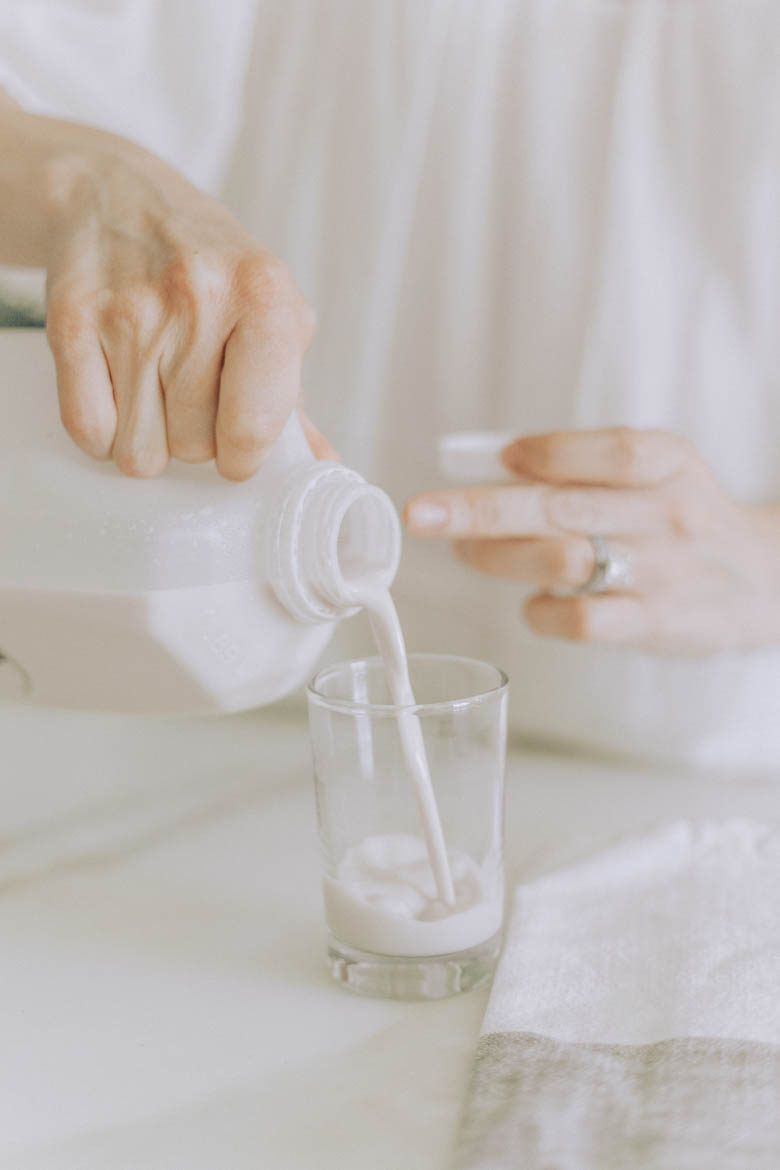Nowadays, most grocery store shelves are just as full of dairy-free nut, hemp, rice, or soy milks as they are cow’s milk. Whether you stumbled upon this page because dairy doesn’t sit well with your digestion, skin, health etc. or you just want an amazing dairy-free alternative, this is the post, welcome to the surprisingly easy and delicious world of homemade nut milks!
In this post, I’m going to go over the what, why, and how of homemade nut milks. I created a full recipe book that you can download below that includes 6 at-home recipes, an ingredient grocery list, what tools you need, and a soaking chart to make any nut milk.
In the recipe book, you’ll learn how to make several nut milk flavors, including…
- VANILLA ALMOND MILK
- GOLDEN CASHEW MILK
- MAPLE PECAN MILK
- CHAI SPICED ALMOND MILK
- STRAWBERRY MACADAMIA NUT MILK
- CHOCOLATE HAZELNUT MILK
These are my absolute favorite creations at the moment. The Golden Cashew Milk saves me a step when I’m making my morning turmeric latte, but the Chai Spiced Almond Milk is perfect for all of you chai latte lovers.
The best part of creating your own nut milk flavors is you can put a healthy twist on classic flavors like strawberry or chocolate and create flavors you could never find at the store. Honestly, have you ever found a Maple Pecan Milk?
But Why Should You Make Your Own Nut Milk?
For me, transitioning to nut milks and a dairy and gluten free diet was not an option because of my autoimmune condition (I have Hashimoto’s). It has completely changed my skin, digestion, gut health, and even energy. But there are so many other reasons to make almond or any nut milk at-home, including:
- TASTE
The first time you taste homemade nut milk you will find out just how much creamier and better it tastes than the store bought stuff. It is not even a comparison! That’s because almond milk should have two ingredients… almonds and water. But check your grocery store’s almond milk ingredients list, it has quite a few more ingredients than just those two right? That’s the only way it can have it’s multi-month shelf life is preservatives and synthetic vitamins. It is much more watered down in the store bought containers which also affects the taste.
- QUALITY
Specific harmful synthetic vitamins usually found in store-bought nut milks are Calcium Carbonate (basically chalk that has anti-acid reactions), Dl-Alpha Tocopherol Acetate (Vitamin E), and Vitamin A Palmitate. I won’t get into all the details but I encourage you to look up these ingredients and see some of the harmful effects. Other added ingredients like carrageenan (possible carcinogen and digestion destruction but makes the milk thicker), locust bean gum, gellan gum, and sunflower lecithin are debated on their health concerns. But at the end of the day it is nice to know EXACTLY what is going into your body.
- DIGESTION
Avoiding those extra ingredients along with sprouting your nuts helps immensely with digestion. Sprouted nuts are basically nuts that have been soaked for about 8 hours releasing the enzyme inhibitors making them easier to digest and make a huge difference in how your body absorbs the nutrients. I have not seen any sprouted nut milk in the market (probably because of the time it takes) but luckily to make homemade almond milk you must soak the nuts to get them soft enough to blend or juice with our home appliances.
I also HIGHLY recommend using raw nuts. “Raw” according to the FDA means that they are heat pasteurized with steam instead of gassed with a Propylene Oxide fumigant to kill any bacteria. Almonds are the only nut by law that must be pasteurized in some sort because of a salmonella outbreak in the 2000’s, which is why especially with almond milk or almond butter I always buy raw.
- CUSTOMIZATION
You can make whatever you want… really! You will see by my flavors I can recreate the old-school favorites like chocolate milk or strawberry milk and get creative and create my own flavors like Maple Pecan or Golden Turmeric Cashew. This makes it really fun for kids as well, they can have those fun flavored drinks with such little clean ingredients. You can even experiment with hybrid cashew-hemp milk or really whatever you think of!
- LESS EXPENSIVE (depending)
This really comes down to the price of the nuts you buy. Since the basics of nut milk is just nuts and water, the nuts are your only cost until you add in something else. As an example, the typical almond milk at the store is around $3-$5 depending. I buy these organic raw almonds that are steam pasteurized and it comes out to $5.50 per 1 cup of almonds which is what I need to create one batch of almond milk. But if you were to buy just Whole Foods’ brand of “Organic Whole Almonds” which are $6.99 and can produce 4 batches of almond milk the cost comes out to$1.75 per batch. Another factor however is if you use the nut pulp/meal than that adds another benefit you don’t get with store-bought.
At-Home Nut Milk 101
Now that you understand a lot about the WHY and some other information to guide you. Let’s go over the nut milk basics!
- Buy the best quality nuts you can afford in bulk
- The longer you soak the nuts, the creamier the milk will be
- Always drain, rinse, and blend/juice nuts with fresh filtered water
- Strain your nut milk with a mesh strainer, cheesecloth, or nut milk bag
- Sweeten if you want, or don’t
- Repeat once a week for optimal freshness
- Use the leftover nut pulp!
How to Use The Leftover Nut Pulp
This is a HUGE benefit of making your own nut milks. The nut pulp can serve so many uses and is a great gluten-free, fiber rich, healthy fat, protein dense, and low carb option in your cooking/baking needs.
Basically, it’s a super nutrient dense food! The most common use of nut pulp is making it into flour, especially with the increase in a popularity of almond flour for paleo, grain-free, or keto eaters. To make the pulp into flour, you basically need to dehydrate the moisture out of it.
Oven:
Evenly spread the nut pulp onto parchment paper and bake in your oven at its lowest setting and bake for 3-8 hours, depending on when it gets completely dry and crumbles. Stir it every now and then to mix it up and test how dry it is.
Dehydrator (why it is my favorite purchase):
Spread the pulp onto a parchment paper covered tray and dehydrate overnight at 115º until dry.
The flour can be used as a substitute in any recipe that uses flour like muffins, pancakes, bread crumbs, pizza crust, and the list goes on. Diego’s favorite (super easy) no-bake cookies are just almond flour, cacao, coconut shreds, and dates mixed together and refrigerated.


